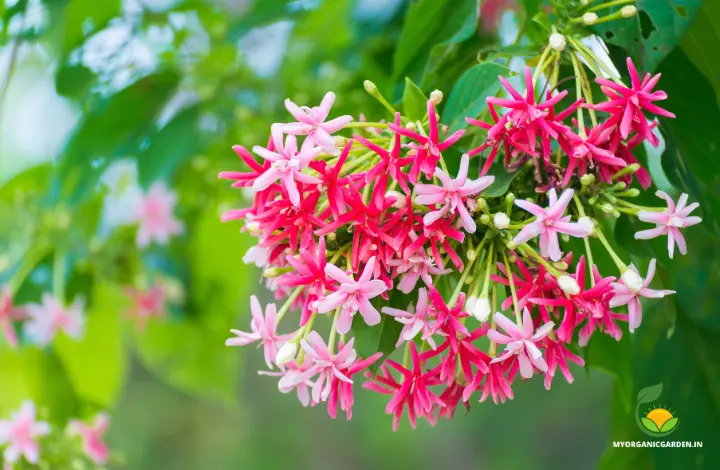In the vibrant world of Indian horticulture, few plants captivate the senses like the enchanting Rangoon Creeper. This fast-growing vine, also called Combretum indicum, Chinese Honeysuckle, or Madhumalti is a real show-stopper. It’s famous for two things: its beautiful flowers and its amazing smell. This makes it a beloved addition to gardens across the country.
Picture this: colorful blooms draped over a trellis, spilling from a balcony, or climbing up a wall. That’s the Rangoon Creeper for you. It’s more than just a plant – it’s a treat for your senses. Gardeners all over India love this plant. It’s not hard to see why. The Rangoon Creeper brings a touch of magic to any space it grows in, turning ordinary gardens into something special.
The Rangoon Creeper – Madhumalti

The Origins of the Rangoon Creeper
The Rangoon Creeper’s name pays homage to its native habitat, Rangoon , former capital of Burma (now Myanmar. This resilient member of the Combretaceae family has since spread its roots to various parts of the world. It thrives in the warm, humid climates of countries like India, Thailand, and the Philippines.
Floral Transformation
The Rangoon Creeper’s most captivating feature is its remarkable floral transformation. As the buds emerge, they start off as delicate white blooms. Gradually they transition to shades of soft pink before finally blossoming into a rich, vibrant red. This ever-changing color palette creates a mesmerizing visual spectacle. The Rangoon creeper attracts a diverse array of pollinators, from butterflies to hummingbirds, who are drawn to the plant’s nectar-rich flowers.
Adaptability and Versatility
One of the key reasons for the Rangoon Creeper’s widespread popularity is its remarkable adaptability. This hardy vine thrives in a variety of soil conditions. It grows well in well-drained, nutrient-rich soils and even more challenging substrates. It is an excellent choice for creating natural fences due to its rapid growth and ability to climb effortlessly.
The Rangoon Creeper’s versatility extends beyond its adaptability. In some cultures, its fragrant flowers enhance culinary delights, adding floral essence to dishes. The plant is believed to have medicinal properties and is used in Ayurvedic practices to treat various ailments, including digestive disorders and skin problems.
Growing Requirements for Rangoon Creeper
Contrary to popular belief, the Rangoon Creeper is relatively easy to cultivate. It requires ample sunlight, consistent watering, and periodic fertilization to maintain its lush foliage and abundant blooms.
Sunlight:
Needs full to partial sunlight. Ideally, it should get 4-6 hours of direct sun daily.
Soil:
Prefers well-drained, fertile soil. A mix of garden soil, compost, and sand works well.
Watering:
Regular watering is essential, but avoid waterlogging. Keep the soil consistently moist.
Support:
Provide a trellis or support. This helps the vine to climb and spread effectively.
Pruning:
Regular pruning helps maintain shape. It also encourages more abundant flowering.
Fertilizing:
Use a balanced fertilizer monthly. Apply it during the growing season for best results.
Container:
Use a large pot with good drainage. This accommodates the root growth adequately.
Rangoon Creeper: A Pollinator’s Paradise
Beyond its captivating aesthetics, the Rangoon Creeper plays a vital role in supporting local ecosystems. Its nectar-rich flowers act as a magnet for a diverse array of pollinators, including bees, butterflies, and hummingbirds. By providing a reliable source of sustenance, the Rangoon Creeper contributes to the overall health and biodiversity of the surrounding environment.
Insect-Repelling Properties
Interestingly, some gardeners have observed that the Rangoon Creeper’s distinctive fragrance may possess insect-repelling properties. This helps to deter certain pests from the surrounding garden. While it may not eliminate all insect problems, this natural deterrent can contribute to a more balanced and harmonious ecosystem.
Cultural Significance
The Rangoon Creeper holds significant symbolic meaning in various cultures. Often associated with themes of love, transformation, and beauty, the plant has become a cherished gift for special occasions and celebrations.
Conclusion
The Rangoon Creeper is a perfect addition to Indian homes for its stunning, color-changing flowers and pleasant fragrance. Its low maintenance requirements and adaptability to balcony gardens make it an ideal choice for novice gardeners. Embrace the beauty and versatility of the Rangoon Creeper to transform your garden into a vibrant, aromatic oasis.
Leave a Reply